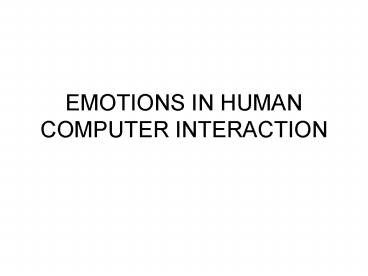EMOTIONS IN HUMAN COMPUTER INTERACTION - PowerPoint PPT Presentation
1 / 22
Title:
EMOTIONS IN HUMAN COMPUTER INTERACTION
Description:
Emotion includes physiological, affective, behavioral, and cognitive components. ... Frustrating interface association of interface with a frustrating emotional state ... – PowerPoint PPT presentation
Number of Views:730
Avg rating:5.0/5.0
Title: EMOTIONS IN HUMAN COMPUTER INTERACTION
1
EMOTIONS IN HUMAN COMPUTER INTERACTION
2
Emotions and HCI
- http//www.youtube.com/watch?vRZfwuCjbBDk
3
What is emotion
- Emotion is a reaction to events considered
relevant to the needs, goals or concerns of an
individual - Emotion includes physiological, affective,
behavioral, and cognitive components. - Fear and joy are examples of it
4
Useful model to understand emotions
Cortex
Thalamus
Physiological Responses
Limbic System
Also called seat of emotion, constantly
evaluates the need/goal relevance of its inputs
Sensory Input (from the environment)
5
Emotions in HCI context
- Why understanding emotions is important in HCI?
- Onscreen objects have the potential to activate
PRIMITIVE EMOTIONAL RESPONSES - Examples objects that appear or move
unexpectedly ? FEAR - http//www.vatican.va/holy_father/special_features
/hf_jp_ii_xxv_en.htm
6
Another example
- Images that seem to approach the user (rapidly
expanding image on the screen, an image that
appears to be flying out of the screen) images
that move in peripheral vision (on the side of
the screen - http//www.globalaigs.org/
7
Do not get confused!
- Emotion, mood and sentiment are not the same
- Emotions are intentional, they imply
relationships with a particular object. - Moods, although they may be indirectly caused by
a particular object, they are nonintentional,
they are not directed to any object in particular - A person can be sad ABOUT SOMETHING (EMOTION)
- Or just DEPRESSED (A MOOD)
8
Sentiment
- Sentiment is also confused with emotions
- Sentiments are not states of an individual but
assigned properties of an object. - Frustrating interface ? association of interface
with a frustrating emotional state
9
Sentiments are important (in HCI)
- Emotions and mood are fleeting (ask a woman!)
emotions lasting only seconds and moods lasting
for hours or even days - Sentiments can persist indefinitely!!!!!
- Sentiments are of critical importance for HCI
because they motivate users to return to a
particular software products or web site
10
Effects of emotions
- Attention
- Emotions has the ability to capture attention.
- They direct and focus our attention on those
objects and situations that have been perceived
as important to our needs and goals, so we can
deal with them appropriately. - Mood influences in attention too. People tend to
pay more attention to thoughts and stimuli that
have some relevance to their current mood state.
11
Effects of emotions
- Memory
- Emotional stimuli are generally remembered better
than nonemotional events - Negative events, which tend to be highly
arousing, are typically remembered better than
possitive events - Mood influences in memory too. We usually
remember factors that are mood-congruent
12
Effects of emotions
- Performance
- Mood has also been found to affect cognitive
style and performance - We do things better, we are more creative and
efficient when we are happy D
13
Effects of emotions
- Assessment
- Mood has also been found to affect cognitive
style and performance. - Users in a good mood will likely to judge both
the interface and their work more positively.
14
What causes emotions?
- Needs and Goals
- The degree to which an interface facilitates
users goals has a direct effect on the emotional
state of the user. - Contagion
- People often catch others emotions
- Moods and sentiments
- Interaction with an object , to which a sentiment
is already attached, can evoke emotion either in
memory of past interaction or anticipation of the
current interaction
15
What causes emotions?
- Previous emotional state
- Users previous emotional state can affect the
experience of subsequent emotions. - Example residues of excitation from a previous
affective reaction will combine with excitation
produced by subsequent affective simulation and
thereby cause an OVERLY INTENSE affective
reaction to subsequent stimuli.
16
Causes of Mood
- Motion has a number of potential causes. The most
obvious is emotion itself. - Contagion Similar to emotion, moods also exhibit
contagion effect. - Depressed person will often make others feel
depressed
17
Causes of Mood
- Color. Color can clearly be designed into an
interface with its mood-influencing properties in
mind. - Warm colors provoke active feelings
- Cool colors provoke extreme reactions
- Example of a web site with bad use of colors
- http//www.dokimos.org/ajff/
18
Causes of Mood
- Other effects
- Music minor scales are typically associated with
negative emotions and mood - Major scales have more positive/happy
connotations - Other possible influences on mood include
weather, temperature, hormonal cycles, genetic
temperament, sleep, food, medicatin and lighting.
19
Measuring Affect
- Measuring user effect can be valuable both as a
component of usability testing and as an
interface technique - Neurological responses. Brain is the most
fundamental source of emotion. Electroencephalogra
m is a way to measure neurological changes.
20
Measuring Affect
- Autonomic Activity consist in measuring certain
components of the autonomic nervous system - Heart (rate increases during fear, followed by
anger, sadness, happiness, surprise and finally
disgust.) - blood pressure
- blood pulse volume
- Temperature
- Pupil dilation
- Muscle tension, among others.
21
Measuring Affect
- Facial expression
- Voice Indicates valence and specific emotions.
- Bored or sad user ? slower, lower pitched speech
- Fear, anger and joy ? faster and louder, with
strong high-frequency energy and more explicit
enunciation.
22
Future Work
- Emotions can be incorporated in systems
- Operating Systems
- Office applications
- Ticket machines

